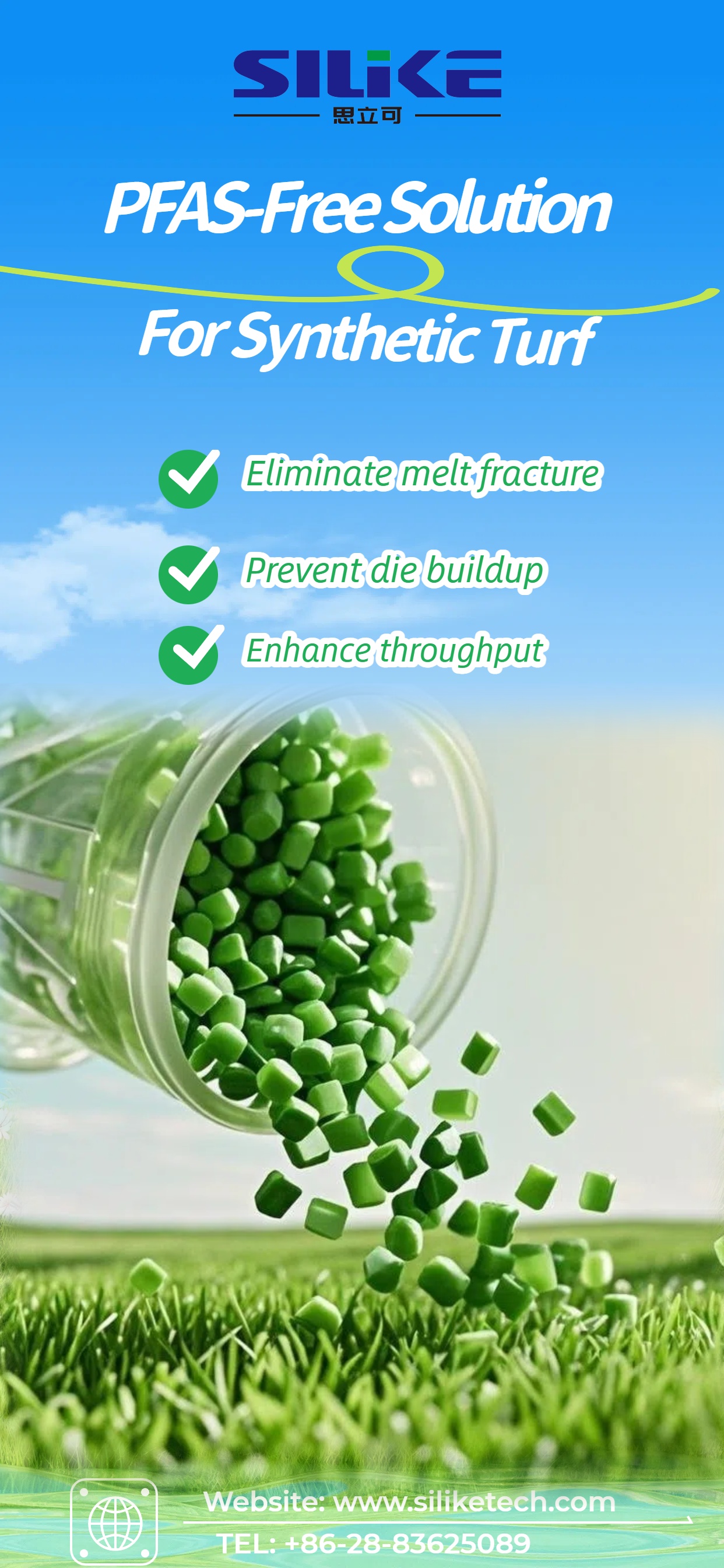Why Synthetic Turf Manufacturers Are Moving Away from PFAS?
Per- and polyfluoroalkyl substances (PFAS) are synthetic chemicals commonly used in various industries, including synthetic turf, for their water-repellent, stain-resistant, and durable properties. However, the use of PFAS in synthetic turf has raised significant concerns, prompting a shift toward PFAS-free alternatives. Below are the key reasons manufacturers are avoiding PFAS and the ongoing quest for PFAS-free process performance additives (PPAs) and fluorine-free alternatives:
1. Health Risks
Issue: PFAS, often referred to as “forever chemicals” due to their persistent carbon-fluorine bonds, are linked to serious health risks, including cancer, immune system disruption, and developmental issues. In synthetic turf, PFAS in carpet backing, blades, or infill can be ingested or inhaled, especially by children or athletes on degraded fields where dust and particles are released.
Evidence: Studies, such as a 2022 Environmental Science & Technology report, found detectable PFAS levels in saliva samples of athletes using synthetic fields.
Industry Response: Major manufacturers now prioritize PFAS-free turf, especially for schools and playgrounds, to mitigate liability and align with duty-of-care principles.
2. Environmental Impact: Preventing Long-Term Contamination
Issue: PFAS do not degrade naturally and accumulate in ecosystems. Turf field runoff has been shown to contaminate water supplies.
Case Study: A 2021 Water Research Foundation study detected PFAS in 78% of groundwater samples near synthetic turf installations.
Regulatory Action: California’s Safe Drinking Water and Toxic Enforcement Act (Proposition 65) lists PFAS as a regulated substance.
The EU’s Registration, Evaluation, Authorisation and Restriction of Chemicals (REACH) framework is phasing out PFAS in consumer goods.
Solution: PFAS-free turf systems eliminate fluorinated coatings and pair with sustainable infills (e.g., cork, coconut husk) to reduce environmental persistence.
3. Regulatory Pressure: Compliance Driving Change
Global Regulations:
U.S.: States like California (Assembly Bill No. 1423, effective 2024) and New York mandate non-detectable PFAS levels in public projects.
EU: Proposed PFAS bans under REACH could take effect by 2025.
Testing Standards: Manufacturers use EPA Method 533 (for solid samples) or ASTM D7968 to certify PFAS-free status.
Industry Adaptation: Companies like TenCate Grass and SYNLawn reformulate Synthetic Turf products to meet these standards, with third-party verification.
Why are PFAS found in artificial grass?
Since the mid-20th century, industries have increasingly adopted fluorinated process performance additives (PPAs) as standard in plastics and textile manufacturing. These additives, which include fluoropolymers like polytetrafluoroethylene derivatives and fluoroelastomers, feature carbon-fluorine (C-F) bonds that are associated with per- and polyfluoroalkyl substances (PFAS).
Historically, fluorinated PPAs, particularly from brand companies like 3M, have played a significant role in enhancing the production of artificial grass. They are commonly used in processes such as blade extrusion and backing coatings. These additives not only improve the efficiency of polyethylene and polypropylene extrusion but also enhance the surface finish, durability, and water resistance of the turf. By minimizing die buildup and preventing melt fracture, they facilitate the creation of uniform fibers, extend the longevity of the product, and reduce manufacturing costs. These advancements have been instrumental in meeting the growing demand for high-performance, low-maintenance turf solutions.
Technologies for PFAS-Free Synthetic Turf: Alternative to fluorine Polymer Processing Aids (PPAs)
SILIKE’s fluorine-free solutions
To address the challenges associated with PFAS, SILIKE launched the SILIMER series. This innovative product line includes a range of 100% pure PFAS-free and fluorine-free polymer processing additives (PPAs), along with PFAS-free and fluorine-free PPA masterbatches. Developed from organically modified polysiloxane, these alternatives not only enhance lubrication and surface properties but also promote a safer, more sustainable approach by eliminating the use of harmful fluorine compounds. By choosing SLIKE SILIMER seriesPFAS-Free PPAs , you can contribute to a healthier environment while benefiting from superior performance.
Benefits of SILIMER series PFAS-Free PPAs:
- Effectively addresses melt fracture (sharkskin)
- Minimizes die buildup, leading to reduced downtime
- Enhances throughput, contributing to greater efficiency
- Improves overall processing properties
- Significantly diminishes surface defects, resulting in a superior surface finish during the extrusion of polyethylene or polypropylene turf blades.
Enhancing Polymer Processing Efficiency: PPA Solutions for Manufacturing
SILIKE ‘s SILIMER series PFAS-Free PPAs are highly valuable across a range of industries. They are particularly suited for applications in synthetic turf (artificial grass), functional masterbatch, plastics film, blow molding, extrusion, fibers, tubes, sheets, and cables. These adaptable Polymer Processing Aids solutions are designed to meet varied production needs while maintaining high performance standards.
Facing growing regulatory and market pressure to eliminate PFAS and fluorine-based additives from their polymer processes? For businesses committed to eco-friendly manufacturing, SILIKE provides a high-performance, PFAS-free solution—perfectly tailored to your needs.
For more sustainable manufacturing Inquiries, please contact Amy Wang at amy.wang@silike.cn or visit www.siliketech.com
Post time: May-23-2025






